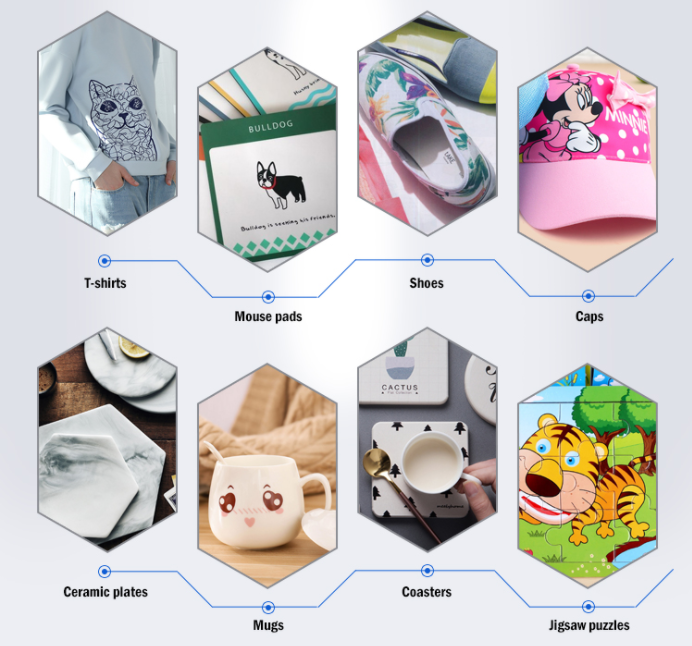Related Knowledge of Thermal Sublimation and Cotton Fabric Printing
September 30,2022
If you are a thermal sublimation transfer printer, you must have heard many times that thermal sublimation technology does not apply to cotton fabrics. To tell the truth, this statement is completely correct. In terms of chemistry, thermal sublimation applies to polyester and polymer rather than cotton fabrics, but that doesn't mean you can't apply it to cotton fabrics.

Some new products on the market can apply sublimation dyes to the surface of cotton fabrics. During the thermal sublimation process, the dye interacts with the polymer in the molecular layer. As far as clothing is concerned, this means that the chemical reaction takes place under the fabric rather than on the surface of the fabric, which is also the reason why the dye will not crack, peel and fade when sublimation clothing is cleaned.
For products sublimated from cotton, the generated pattern is attached to the surface of the fabric rather than inside the fabric, and cracks, peeling and fading will occur after repeated washing over time. However, this is not a matter worth worrying about, because screen printing and digital direct printing have the same traditional printing methods.
In the past few months, some new products applied to the thermal sublimation of cotton matrix came out, mainly divided into two categories: transfer paper and printing materials. Here we mainly talk about transfer papers.
About Transfer Paper
The operation of thermal sublimation printing with transfer paper is very simple: select a suitable transfer paper to print on the printer, and then use a hot press to print the pattern on the T-shirt. With the chemical element reactive dyes attached to the surface of the cotton T-shirt from the paper, the transfer paper is discarded, which is the basic thermal sublimation transfer process. It sounds simple, but it is true. However, because transfer papers are very different, it is important to test different products and evaluate the results.
At present, the transfer paper on the market is composed of some kind of polymer, which acts as an intermediate medium to attach the pattern to the cotton cloth. During processing, the whole transfer paper will be dyed with dye. When the image is applied with a hot press, the pigment and ink will be stripped off the paper and printed on the clothes together. However, for some products, some places that do not need printing and dyeing will also be printed with patterns.
For example, a small mark is printed in the middle of the rectangular transfer paper. During the hot pressing process, the mark and the blank area of the paper will also be transferred.
You can use scissors to cut the extra paper around the printing pattern, leaving only the place to transfer. If the number of prints is large, it is recommended to buy a paper cutter that can automatically cut paper. This may increase the operation steps, but it will be worthwhile.
The second type of transfer paper is called "self removing paper", in which only the places coated with dye can be transferred. It sounds like a good choice, but this kind of paper also has disadvantages. First, the hot press printing process must be fast; Second, this paper is more suitable for printing dark patterns, while the transfer effect of light patterns is not good.
In contrast, the first transfer paper is more suitable for printing light color patterns. In other words, the selection of transfer paper is not so simple. Therefore, it takes time to test the transfer paper and printing process to select the most suitable paper.
The use of sublimation cotton transfer paper is much more complicated than selecting products. Digital transfer paper has many different characteristics, which will affect the color and quality of the image. Transfer paper should absorb dyes and release them properly. Different transfer papers have different effects. These factors should be taken into account when operating.
Software Factors
The key to solving the printing problem is to use color management printing software. For example, the software can provide different "configuration templates" for different transfer papers, set parameters in the printer, and then control the transfer of dyes according to the characteristics of the transfer paper and dyes. Too much ink will lead to waste and streaks, while too little ink will lead to darkening or color deviation. Keep in mind that the correct matching settings can bring the best quality. When using the printing software, simply select the matching settings, and the software and printer will help you complete the rest of the work.
If you use a raster image processor (RIP), you can try to choose the appropriate device for different types of transfer products. If you do not have RIP or system-specific software, you can seek advice from your sublimation system equipment manufacturer.
So far, I have used six thermal sublimation transfer products for cotton, which are different but very useful. In addition, generally speaking, these new products will have more functions while continuously improving the process, for example, sublimation transfer printing can be carried out on a dark cloth.
The appearance of these new products will open the door to the application of thermal sublimation technology and help your clothing business maximize potential profits.
If you want to custom sublimation printer, wholesale sublimation fabric printing machine, dye sublimation printer manufacturers, plz feel free to contact us.